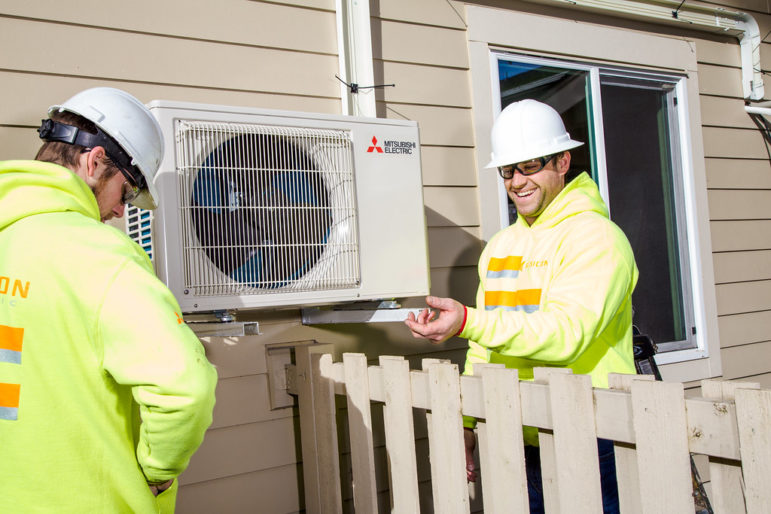
In a nutshell:
– Heat pumps can help us successfully transition energy consumption away from fossil gas to zero- and low-carbon electric alternatives.
– There are air-source heat pumps (ASHP) and ground-source heat pumps (GSHP). In heating mode, both types take heat from the outside air or ground and pull the heat into your home. Both types can also be run in cooling mode.
– Heat pumps remain remarkably energy- and cost-efficient even on very cold days.
– Paired with weatherization programs and backup heat sources in existing buildings, air-source heat pumps are fantastic tools for accelerating the transition to clean electric energy that powers homes, hospitals, and businesses.
– In new construction, better building standards and codes help facilitate air-source heat pump deployment without the need for backup heat options.
– Ground-source heat pumps provide reliable heating year-round and can be deployed in existing and new buildings without the need for backup heat options or deep energy retrofits.
Heat pumps have been having a “moment” lately—and rightfully so. Avoiding the worst impacts of climate change means transitioning our entire economy, starting here in Minnesota, to be carbon-neutral by 2050. That requires a dramatic change in the energy that powers our homes, businesses, and workplaces, shifting away from burning fossil fuels towards using zero- and low-carbon alternatives. Heat pumps can help us make that transition.
Fresh Energy staff have been fielding many heat pump-related questions from Minnesotans, ranging from builders, to architects, to people striving to transition where they live and work away from burning fossil gas for heating, and everyone in between. As heat pump innovation and adoption continues to advance in Minnesota and across the Midwest, public awareness on this topic will also grow. But, for now, let’s start with the basics!
What is a heat pump? How does it work?
A heat pump serves as one type of heating and cooling system that is installed outside a home, multifamily residence, or business. Heat pump technology has come a long way over the past decade, with improved energy efficiency and increased capacity to heat in cold climates. Traditional electric resistance heating—the classic baseboard heating system that you’d see in your grandparents’ basement—requires running an electric current through a material that has some resistance to cause friction, which creates heat. That heat is then dispersed throughout the home, office building, or apartment. By contrast, in heating mode, a heat pump takes heat from the outside air and pulls it into the building—and it can do that with exceptional energy efficiency even on really cold days when it doesn’t feel like there could be any heat outside! The pump operates in reverse when it’s in cooling mode pulling heat out of your home.
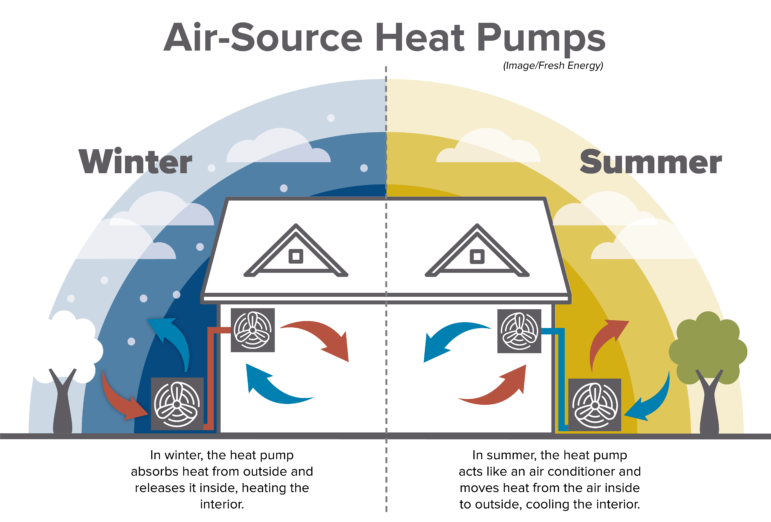
But just how do they work? There are a couple different types of heat pumps. The type described above, an air-source heat pump (or ASHP, see Graphic 1), takes heat from the outside air and pulls it into your home. Operating in a similar fashion, ground-source heat pumps (or GSHP, see Graphic 2), both geothermal and aquifer thermal energy storage system (ATES) types, take heat from a fluid—usually water—that is being transported through pipes and move it into the air, like the ground-source system proposed for Saint Paul’s Como Zoo. ATES technology makes the most sense on district scale, instead of in individual homes. Because ground-source heat pumps exist underground, the water they contain is heated by the Earth itself. This provides a constant warm temperature for the heat pump to redistribute into a space, like your home. Both types simply redistribute heat—they do not create it.
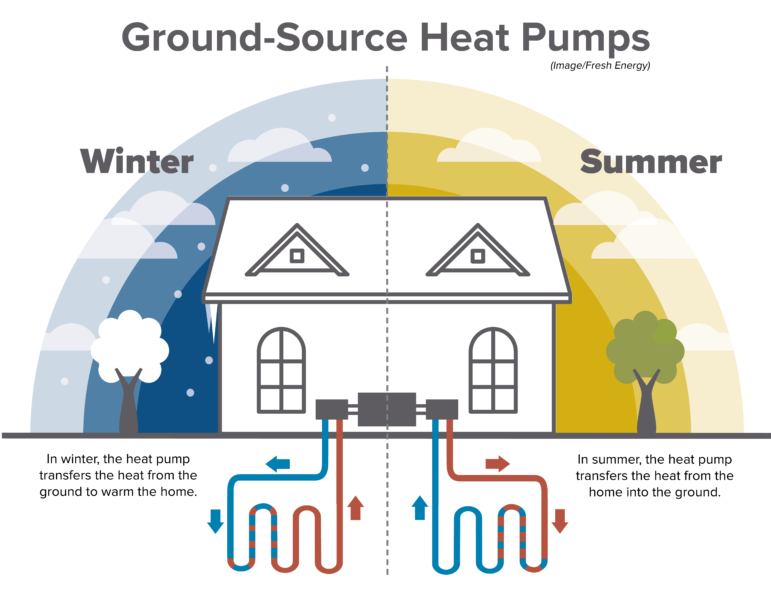
What are some of the misconceptions about heat pumps?
That they don’t work in cold weather. Ground-source heat pumps draw from the constant, consistent heat of the Earth’s core, so they do not present any concerns in winter—they will remain in operation and be energy efficient even on polar vortex days. Air-source heat pumps require a bit more consideration because the efficiency of their operation is constrained by something called the “cold climate cut-off,” the lowest outdoor temperature at which an air-source heat pump would shut off. Because of advancements in heat pump technology, there are cutting-edge models today, like the Arctic EVI 035ZA/BE and General Electric’s Endure that will heat down to negative 22 degrees Fahrenheit or negative 30 degrees Fahrenheit, respectively.
The market itself is moving to accommodate even cold climates like ours here in Minnesota and the upper Midwest. However, in existing buildings, it’s still best practice to have a backup form of heat ready for those really cold days in the thick of winter if you are installing an air-source heat pump. In that case, Fresh Energy’s lead director of energy transition Margaret Cherne-Hendrick says, “We really need to be improving the energy efficiency of buildings, either through weatherization or deep energy retrofits, when we install air-source heat pumps in order to minimize the need for backup heating. We should be using more efficient models of resistance backup heating such that we can sustainably grow new electric demand that we’re expecting the grid to serve.”
That they’re expensive. Local utilities provide several rebate programs for both air-source and ground-source systems, including Xcel Energy, Minnesota Power, Otter Tail Power Company, Connexus Energy (offers incentives only for ASHP), and Dakota Electric, that help offset the cost of having a heat pump installed. What’s most important to remember is that, because heat pumps move heat rather than generate it, they can heat or cool a space for as little as one quarter of the cost of operating conventional heating or cooling appliances, making them a savvy long-term investment.
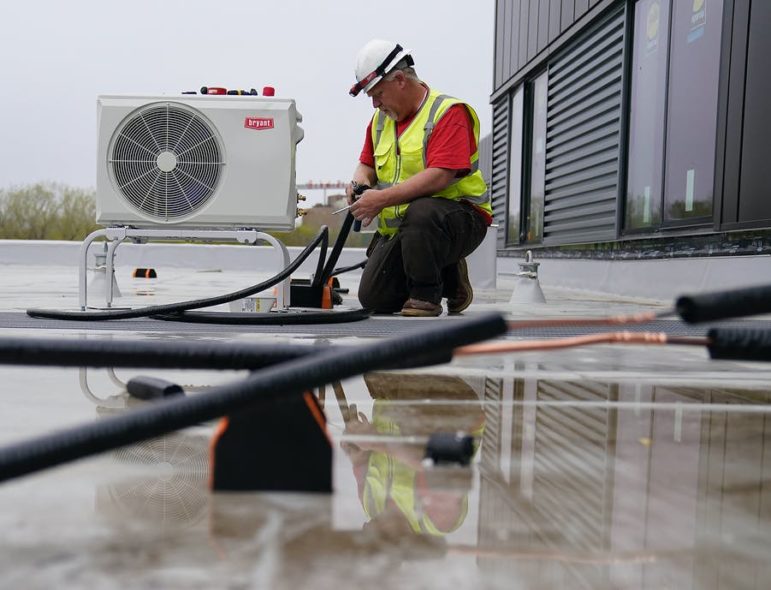
Additionally, the ECO Act—a longstanding Fresh Energy priority that provides critical updates to Minnesota’s bedrock energy efficiency policy, the Conservation Improvement Program (CIP)—includes fuel-switching incentives for households and businesses wanting to make the switch from a fossil gas heat source (natural gas, propane, heating oil) to an electric system, like a heat pump. Thanks to the ECO Act, utilities investing in that change can count those allocations toward their Conservation Improvement Program spending. And, as the Energy News Network reports, “The Minnesota Air Source Heat Pump Collaborative has identified rebates available to customers in nearly every utility territory,” with rebate amounts ranging from $200 to $2000.
That they don’t work in older homes or are difficult to install. Because the use of heat pumps is still relatively new to many Minnesotans, there is a misunderstanding that heat pumps only work in residences that have a ducted HVAC system. However, ductless mini split systems provide just as much of an opportunity to install a heat pump. Mini split systems have a handful of central parts—an indoor unit like a furnace, an outdoor unit like an air conditioner or heat pump, a thermostat, and more—and are most common in multifamily housing or as retrofit add-ons to houses with non-ducted heating and cooling systems.
Additionally, because widespread use of heat pumps is still scaling, many contractors haven’t had a chance to develop the same level of comfortability with heat pump technology that they have with more conventional technologies. As consumer interest grows and the market moves to meet the moment, familiarity with heat pump technology among building professionals is sure to expand as well.
That they only heat. When thinking about heat pumps, it is important to remember that they do not create heat. In heating mode, a heat pump redistributes, or transfers, heat that already exists in the air or underground to an indoor space. In cooling mode, a heat pump absorbs the heat that is inside your home and releases it outside. High-efficiency heat pumps also dehumidify better than standard central air conditioners, resulting in less energy usage and more comfort when in cooling mode.
What opportunities do heat pumps present in terms of current innovation and federal boosts?
State funding and federal legislation. Heat pumps are a major focus of funding through the American Jobs Plan. Congress will decide when to disperse the money from the American Jobs Plan, and then it will be funneled toward state governments. A lot of this funding will be dedicated to installing heat pumps, especially in low-income households, and accelerating market development and market adoption of heat pumps. We’ll also see increased funding for existing programs that are seeking to improve energy efficiency through weatherization, as well as elevated opportunities to simultaneously implement fuel switching to accommodate electrified appliances. The Zero-Emission Homes Act, which was introduced this July, would aid in that process, helping provide rebates for the purchase and installation of electric appliances and equipment in single-family homes and multifamily buildings, with additional support for under-resourced and moderate- income households. Led by U.S. Senator Martin Heinrich (D-N.M.), a member of the Senate Energy and Natural Resources Committee, the bill is co-sponsored by U.S. Senator for Minnesota Tina Smith and also has strong support from U.S. Senator for Minnesota Amy Klobuchar.
New jobs, healthier environments, and cheaper utility bills for U.S. residents. The U.S. Department of Energy (DOE) has also begun backing heat pump technology. For years, the DOE has been researching, developing, and deploying innovative technologies to make buildings more efficient—and collaborating with industry partners to make sure they are relevant for everyday customers. That research and development presents a central truth: Equitable decarbonization of buildings leads to the creation of new clean energy jobs, healthier environments, and cheaper utility bills.
How do heat pumps connect to greater building decarbonization?
Fuel-switching and energy efficiency that slows climate change. The term “building decarbonization” refers to the process of converting appliances like furnaces, water heaters, and stoves from fossil fuels to clean, carbon-free electricity. That process includes energy efficiency and weatherization, but it must include electrification in order to eliminate emissions and not merely reduce them. Heat pumps present an opportunity to fuel switch away from fossil fuel-dependent appliances in today’s homes toward improved energy efficiency, a reduction in greenhouse gas emissions (GHGs), and improved health and safety.

Here in Minnesota, many of us depend upon fossil gas—also known as natural gas—every day to cook, heat our shower water, dry clothes, and warm our homes and businesses. But there is strong and growing evidence that using natural gas poses significant risks, including carbon monoxide poisoning, fires, and explosions.
Gas stoves alone can emit elevated indoor nitrogen dioxide (NO2) levels often exceeding indoor guidelines and outdoor standards. And, new studies show that burning natural gas, biomass, and wood has more negative health impacts than burning coal in many states. Using cold-climate air-source or ground-source heat pumps helps shift away from those risks. That’s why heat pump development and adoption is one priority area for the Midwest Building Decarbonization Coalition, a project of Fresh Energy that is working to develop and implement equitable strategies to achieve zero emissions from the Midwestern building sector.
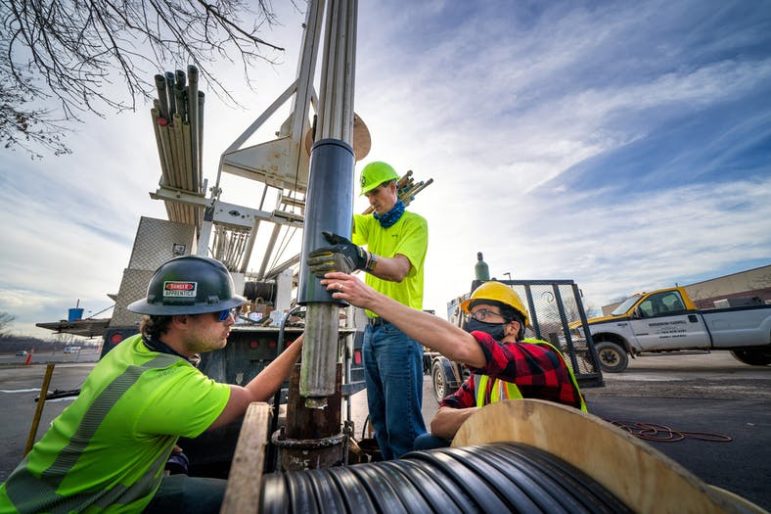
Urban implementation through interconnection. Lead director of energy transition at Fresh Energy Margaret Cherne-Hendrick says that, when implementing ground-source heat pumps, “The real value is not in single systems but in many interconnected systems that comprise a district energy configuration,” which carries significant opportunity for dense urban areas. District energy systems—like the one proposed for the Towerside Innovation District (see photo above) in the Prospect Park neighborhood of Saint Paul—provide many benefits. These benefits include economies of scale during implementation, reliable heating in existing buildings without much weatherization needed, much higher degrees of energy efficiency due to sharing of waste heat across buildings that have different energy use profiles (resulting in lower energy bills and sustainable growth of new electric demand), as well as the labor opportunities district systems present for workers currently engaged in fossil gas systems. Fresh Energy recently hosted Darcy Solutions and Pipefitters Steamfitters Local 455 for a webinar discussing how district-scale heat and power projects achieve carbon reductions and union jobs. You can watch the webinar recording here, or listen to the conversation in podcast form on Decarbonize: The Clean Energy Podcast here.
How do heat pumps intersect with Fresh Energy priorities?
A key part of Fresh Energy’s work is identifying opportunities to lead a healthy transition from oil and gas to clean, renewable electricity that powers where we live and work, as well as how we get around. Since heat pumps are a form of beneficial electrification, Fresh Energy staff are plugged in:
- At the Minnesota Public Utilities Commission (PUC), advocating for building electrification pilots and programs that incentivize and pilot adoption of ground-source and cold-climate air-source heat pumps.
- At the Minnesota Legislature, contributing to and advocating for policies that incentivize utilities to play a bigger role in building decarbonization programming via fuel switching.
- With city councils and commissioners, making research-based recommendations as they form climate action plans and work to combat rising natural gas emissions in the buildings sector.
- Within organization-wide communications and public engagement, in service of the public policy platform Fresh Energy developed in 2018 and expanded into a strategic imperative in 2020. That imperative is to create a carbon-neutral economy through high-impact integrated solutions, such as beneficial electrification—which includes advancing heat pumps among partners, stakeholders, and Minnesotans. Beneficial electrification plays a key role in a just energy transition, and takes into consideration the major economic, equity, and labor implications of the ongoing shift to clean energy.
Beneficial electrification is just one part of Fresh Energy’s work across the energy sector—at legislative, agency, and local levels—to help Minnesota meet its carbon reduction and climate goals and swiftly decarbonize our energy system. Fresh Energy staff will continue working in the public interest to identify and advocate for the implementation of policies and practices that advance fossil gas alternatives in the transportation and building sectors for the benefit of everyone in Minnesota.

